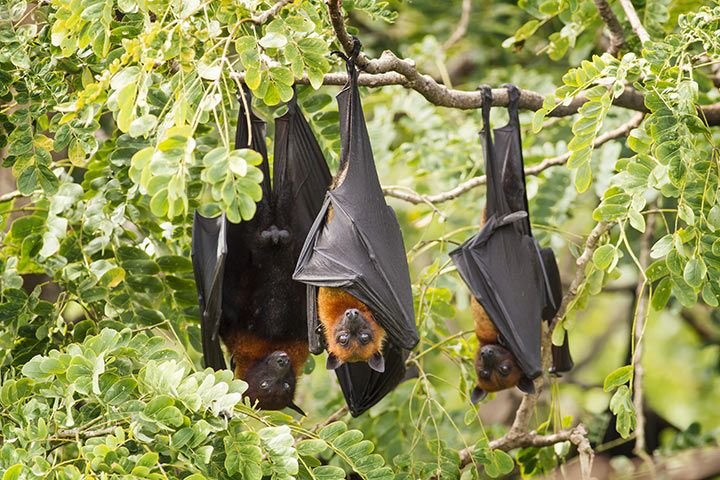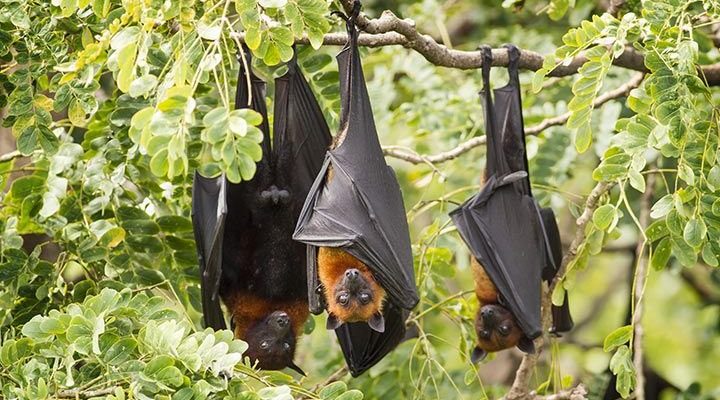
When we talk about fruit bats, we’re generally referring to the larger species within the family Pteropodidae. These bats are known for their impressive wingspans, some reaching over six feet! They’re also important pollinators and seed dispersers in many tropical and subtropical regions. Understanding their habitat and distribution gives us a glimpse into their survival, behaviors, and the environmental needs they depend on. So, where exactly do they live, and what makes their homes so ideal? Let’s break it down.
The Primary Habitat of Fruit Bats
Fruit bats thrive in tropical and subtropical forests. These environments are often dense with various fruit-bearing trees, providing the perfect buffet for these bats. Imagine walking through a vibrant rainforest, where the air is filled with the sweet scent of ripe mangoes, guavas, and figs. This rich banquet is essential for fruit bats, whose diets consist mainly of these fruits.
Typically, we find fruit bats in regions like Southeast Asia, Africa, and parts of Australia and the Pacific Islands. They prefer habitats that offer both food and shelter. Tall trees with open canopies allow them to take off and land easily while also providing a safe place to roost during the day. When you think about it, the complexity of their habitat is like a well-stocked kitchen: it’s all about having the right ingredients to whip up a delightful meal.
Roosting Behavior
When night falls, fruit bats are on the move, but during the day, they need a cozy place to rest. They often roost in large colonies, hanging upside down in trees or under cliff overhangs. This behavior serves multiple purposes. For one, the closeness of these colonies offers protection from predators. Think of it as living in a tight-knit community, where everyone looks out for each other.
Another reason for this communal living is warmth. While bat flight can be exhausting, resting in a group helps conserve energy. In cooler climates, living close together keeps them warm and maintains a stable microclimate. The sheer sight of hundreds of bats nestled together is both awe-inspiring and a little eerie, like a scene from a fantastical movie.
Global Distribution of Fruit Bats
Fruit bats aren’t shy about covering territories; in fact, they can be found in a wide range of locations. Their distribution mainly aligns with tropical regions, but it’s not entirely limited to these areas. They can be spotted in places where food sources are abundant and the climate is suitable for their survival.
For example, you might find species like the Indian flying fox in India and throughout Southeast Asia, while the grey-headed flying fox is commonly found in eastern Australia. These bats adapt to their surroundings, sometimes even venturing into urban areas, as long as there are fruit trees to sustain them.
Here’s a quick look at some popular fruit bat species and their primary habitats:
| Species | Location | Habitat |
|---|---|---|
| Indian Flying Fox | India, Southeast Asia | Tropical forests and mangroves |
| Grey-headed Flying Fox | Eastern Australia | Woodlands and urban green spaces |
| Pacific Flying Fox | Pacific Islands | Tropical forests |
Impact of Habitat Loss
While fruit bats are generally adaptable, they face significant challenges due to habitat loss. As we clear forests for agriculture, urban development, or logging, we’re not just losing beautiful trees; we’re also disrupting the entire ecosystem that sustains these bats. This loss can lead to dwindling food sources, forcing bats to travel farther for their meals, sometimes leading to conflicts with humans.
Honestly, it’s a crucial time for conservation efforts. Preserving their habitats not only helps fruit bats but also supports the health of entire ecosystems. Remember, when we protect these flying friends, we’re also ensuring that plants get pollinated, seeds get dispersed, and forests remain vibrant and healthy.
Types of Fruit Bat Habitats
Fruit bats are adaptable creatures but tend to favor specific types of habitats. Here are a few common ones:
- Tropical Rainforests: These dense forests are teeming with life and provide a stable food source throughout the year.
- Coastal Mangroves: Mangroves offer fruits and flowers while also serving as roosting locations.
- Woodlands: Open woodlands allow fruit bats to navigate easily while still providing access to fruit trees.
- Urban Areas: Surprisingly, some fruit bats thrive in cities, especially where parks or gardens have fruit-bearing trees.
Each of these habitats plays a unique role in the life cycle of fruit bats. For instance, tropical rainforests host a variety of fruiting trees that bloom at different times, ensuring a steady food supply. Meanwhile, urban areas may offer unexpected resources, although they can also come with dangers, like traffic or habitat fragmentation.
Temperature and Climate Preferences
Temperature and climate are also critical factors in fruit bat habitats. Most prefer warm climates, as they are less active in cooler weather. This need for warmth means that we mostly find them in tropical and subtropical regions. However, with climate change affecting global temperatures, the habitats of fruit bats may shift, impacting their distribution patterns.
Here’s the thing: temperature changes can also affect the fruiting cycles of trees. If trees bloom too early or too late, it could throw off the bats’ feeding schedule. As such, maintaining healthy climates is crucial for the survival of these remarkable creatures.
The Role of Fruit Bats in Their Ecosystem
Fruit bats aren’t just cute; they also play a vital role in their ecosystems. When they munch on fruit, they help with pollination and seed dispersal. Imagine them as nature’s gardeners! As they fly from tree to tree, they carry seeds far and wide, allowing forests to regenerate. This is particularly important in areas where trees struggle to grow.
Pollination is another essential aspect of their contribution. Many plants have evolved to rely on bats for reproduction. Without them, certain fruits and flowers may struggle to survive. This interdependence highlights why it’s so important to protect their habitats. When fruit bats thrive, ecosystems thrive.
Human Impact and Conservation Efforts
Human activities are always a double-edged sword. While many people appreciate fruit bats for their role in nature, others view them as pests. Habitat destruction, hunting, and disease transmission are major threats to their populations. However, community-based conservation efforts are helping to educate people about the importance of these bats.
Honesty, it’s inspiring to see local organizations working to create awareness. Some initiatives involve planting fruit trees to provide food sources, while others focus on protecting existing habitats. By fostering coexistence between humans and fruit bats, we can help ensure their survival for generations to come.
Understanding where fruit bats live is more than just an exploration of their habitats; it’s also about recognizing the vital roles they play in our ecosystems. These remarkable creatures depend on lush forests, mangroves, and even urban green spaces to thrive. The interconnections between fruit bats, the environment, and humans are complex, but each plays a part in maintaining the balance of nature.
As we face challenges like climate change and habitat loss, we must take action to protect these flying wonders. By providing safe spaces and promoting biodiversity, we can help ensure that fruit bats continue to soar through the skies, spreading seeds, and pollinating plants. So, next time you think about fruit bats, remember their homes and contributions—they’re essential parts of our vibrant world!

